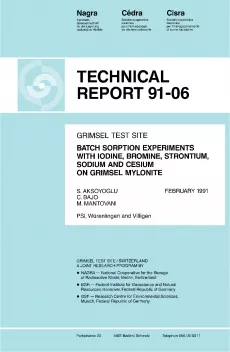
Technical Report NTB 91-06
Grimsel Test SiteBatch sorption experiments with iodine, bromine, strontium, sodium and cesium on Grimsel mylonite
A laboratory support programme has been running in advance of the migration experiments at the Grimsel Test Site (GTS). This report describes the results from batch sorption experiments carried out with iodine, bromine, sodium, strontium and cesium.
Protomylonite surrounding the fracture at the migration site (AU 96) was not available in sufficient amounts, so mylonite from an adjacent fault zone (AU 126) was used for all the laboratory experiments. All the work has been carried out in glove boxes in a nitrogen atmosphere with very low O2 and CO2 levels (< 10 ppm). Mylonite was equilibrated with the natural Grimsel groundwater (NGW) prior to sorption experiments. The first series of sorption experiments were carried out without shaking (to avoid creating fresh surfaces). This caused sedimentation of the mylonite and led to slow kinetics. In the later experiments therefore, gentle, continuous agitation was used.
No sorption (Rd < 0.1 ml/g) of iodine and bromine on mylonite was observed under the experimental conditions used.
It was observed that the sorption coefficients of 85Sr and 22Na (65 – 110 ml/g and 2.3 – 3.5 ml/g respectively) were not affected by varying nuclide concentrations, provided these were kept much below their natural levels in NGW. This indicates that, in this nuclide concentration range, isotopic exchange takes place. Sorption coefficients did not vary with the rock/water ratio. Experiments with a bulky displacing cation (silver thiourea) suggested that some sodium ions were on less accessible internal sites and this could account for the slow kinetics for sodium. Further experiments with samples with smaller particle size confirmed this hypothesis.
Batch sorption experiments on mylonite at initial cesium concentrations of between 3.2 × 10-8 and 5.0 × 10-4 M showed that sorption was reversible and non-linear; sorption coefficients were between 3800 and 21 ml/g. Increasing the potassium concentration in the solution led to reduced sorption of cesium, suggesting that Cs and K compete for the sorption sites. At the lowest Cs concentration used, sorption appears to be due to exchange with K at specific sites on mica, together with possible isotopic exchange. For these conditions and by making some assumptions, a Cs sorption coefficient for waters with different K concentrations could be estimated. Extrapolation of laboratory data for cesium to the field is rather difficult because of slight but potentially significant differences between the mylonite used in the laboratory and the protomylonite in the field.
